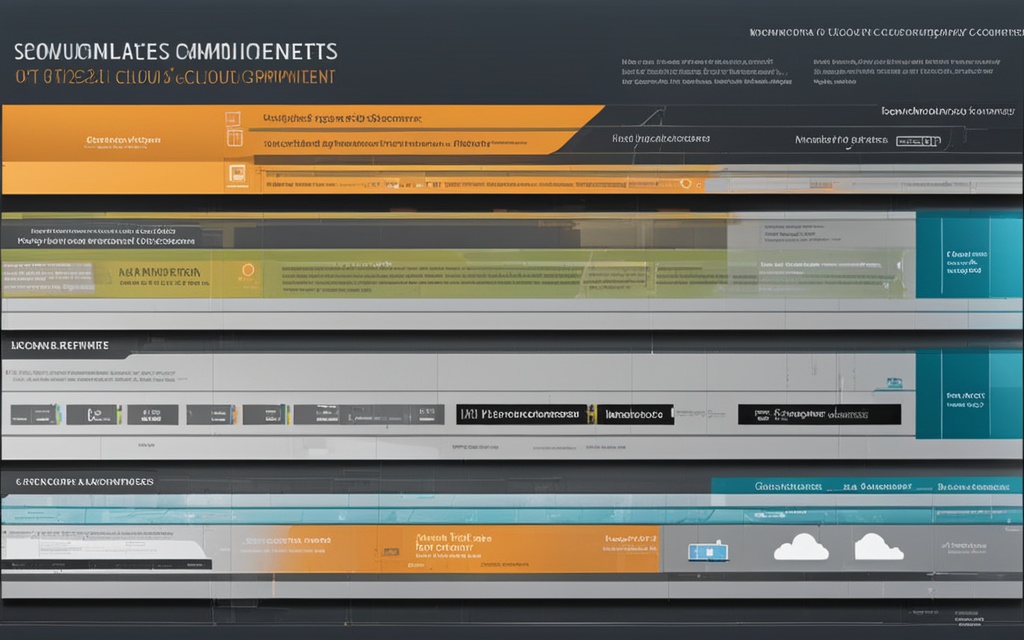Table of Contents
The evolution of cloud computing has been a remarkable journey, touching decades of innovation. The cloud computing history timeline starts in the 1950s with mainframe computers. These computers were the beginning of time-sharing systems.
These time-sharing systems made it possible for many users to access one computer. This was a key step towards the sharing of computing resources that we see in today’s cloud computing1. By the late 20th century, the idea of the ‘cloud’ appeared. It was shown as a symbol in network diagrams. This symbol showed how computing services could be given through the internet1.
In the 1990s, important steps forward were taken. With the launch of Amazon Web Services in 2002, cloud technologies took a big leap. This was a key moment for cloud computing to become widely used. In the 2000s, IaaS and SaaS became more popular across different big platforms. When we look at the cloud technologies milestones, we see a story of ongoing innovation. This innovation has made cloud computing a core part of business and industry today.
Key Takeaways
- The evolution of cloud computing has roots in mainframe computer usage and time-sharing systems from the 1950s.
- The cloud symbol began representing networked computing in the 1970s, illustrating the delivery of services over the internet.
- The launch of significant platforms like AWS and Microsoft’s Azure drastically transformed the landscape of business computing.
- Understanding the various components and deployment models of cloud computing is essential for modern businesses.
- Cloud computing allows enhanced scalability and resource-sharing capabilities for organisations globally.
Introduction to Cloud Computing
Cloud computing is a big deal in today’s digital world. It’s all about using the internet to deliver different computing services. This includes things like servers, storage, databases, networking, software, and more. It makes it easier for businesses and people to access tech resources. They can do this without having to invest a lot in their own local systems. Check out this overview of cloud services to learn more about it2.
Thanks to cloud computing, we can use apps and handle data without spending lots of money on our own hardware. Experts think that, in 2023, people around the world will spend about $592 billion on public cloud services. That’s a lot of money, and it shows how important and big cloud computing is becoming. It comes in different forms, like Infrastructure as a Service (IaaS), Platform as a Service (PaaS), and Software as a Service (SaaS). These options make cloud computing very flexible and useful for many kinds of users2.
When we talk about where cloud computing came from, we look at three important times: the 1960s, the early 1990s, and the early 2000s. These periods show the history and development of cloud computing. Using cloud computing has lots of benefits. For example, it offers scalable storage, powerful computing, and better tools for teamwork. These all help to make businesses more productive. The way computing technology has grown over the last seventy years has made the cloud a key part of doing business today2.
To sum up, cloud computing has really changed how companies work, giving them lots of new chances to be innovative. With many different services available, organisations can get the most out of cloud technology. This leads to big cloud computing benefits like growth and more efficiency, which is crucial in a competitive market2.
Early Developments in Computing
The journey of modern computing started in the 1950s, with the emergence of mainframe computing. These hefty machines became essential for governments and big companies. They made a huge leap in how tasks were handled. This era laid the groundwork for the tech advances we see today.
1950s: The Advent of Mainframe Computing
Mainframe computing began with large, expensive machines needing special rooms. They were so costly, only entities like governments and universities could afford them. To improve these systems, specific programming languages were developed.
1960s: Time-Sharing and the Birth of Cloud Concepts
The 1960s brought the idea of time-sharing computing. It let multiple users operate a single mainframe from different locations. This made better use of resources and led to the cloud services we have now. John McCarthy even suggested computing could be a utility, just like water or electricity. His ideas predicted the cloud systems we depend on today.
https://www.youtube.com/watch?v=ip0cQiQjd18
| Decade | Key Development |
|---|---|
| 1950s | Establishment of mainframe computing for extensive calculations |
| 1960s | Introduction of time-sharing computing, laying groundwork for early cloud concepts |
This progress in mainframe computing history led to shared use of powerful machines. This paved the way for the cloud technologies we use now. Knowing this history helps us understand today’s computing trends and what might come next3.
The Birth of the Cloud Computing History Timeline
The journey of cloud computing began in the 1990s. This era was full of new discoveries that shaped cloud computing development 1990s. More people could access the internet, leading to the creation of new technologies. This shift changed how businesses operated. Many companies started during this time, sparking the rise of cloud services which changed tech forever.
1990s: Emergence of Key Technologies and Companies
In 1997, Professor Ramnath Chellappa called it a new computing paradigm. This moment was crucial for cloud computing4. Salesforce revolutionised things in 1999 by introducing software over the internet. They created the Software as a Service (SaaS) model. This showed how powerful cloud technology could be5. Their work showed how the internet could be used to offer new services. This kickstarted the rise of cloud services.
2000s: Cloud Computing Goes Mainstream
The 2000s were a key time for mainstream cloud computing. In 2006, Amazon Web Services (AWS) launched, introducing Elastic Compute Cloud (EC2). This service allowed companies to rent computing power. It made advanced computing available to more people6. Google Docs also started, showing how cloud services were growing.
Major Milestones in Cloud Computing
The history of cloud computing is marked by major milestones that have created the digital world we know today. Each important step in cloud computing has led to the powerful services we use now. This timeline shows the key moments in cloud computing’s exciting journey.
Timeline of Significant When
| Year | Event | Description |
|---|---|---|
| 1950s | Introduction of ‘Cloud Computing’ | The very first mention of “Cloud Computing” started the journey of computing from afar. |
| 1971 | Intel 4004 | The launch of the first commercial microprocessor set the stage for future computing tech. |
| 1980s | Cluster Computing Emerges | Cluster computing came about as a new option, linking many computers for more power. |
| 1990s | Grid Computing Concept | Grid computing helped link different computing resources across distances. |
| 1999 | Launch of Salesforce | Salesforce introduced Software as a Service (SaaS), changing how businesses access software. |
| 2004 | Web 2.0 Popularity | The arrival of Web 2.0 meant more interactive websites, key for cloud services. |
| 2015 | AWS Revenue | Amazon Web Services earned $7.88 billion, leading the cloud computing industry7. |
| 2017 | Cloud Industry Growth | Cloud computing’s worth hit $260 billion, proving its fast growth7. |
| 2018 | Microsoft Acquires GitHub | Microsoft’s $7.5 billion GitHub buy marked a big cloud tech investment7. |
Cloud computing’s journey shows how technology has changed from the 1950s to now. It’s moved from big mainframes to the dynamic cloud services we see today. Cloud benefits like cost savings, flexibility, and scalability keep attracting more businesses8.
Current Trends and Future of Cloud Computing
As we look into the future of cloud computing, we see rapid changes. More companies are seeing the benefits of being flexible. This leads them to use cloud solutions to get better and grow faster. In 2020, 61 percent of businesses moved their work to the cloud, showing a big change in their plans9. The COVID-19 pandemic made this move quicker, making many start working from home.
The current cloud trends show a clear choice for both multi-cloud and hybrid approaches. These methods help use resources well and lower risks. The cloud computing industry is expected to reach a huge $1 trillion by 2024. This growth is thanks to a 15.7 percent yearly increase9. Services like Software as a Service (SaaS), and others will likely make up more than 60 percent of cloud income9.
There’s a big focus on keeping data safe and private in cloud tech. Over half of US companies now use cloud-managed services. They plan to grow these services in the next two years9. The growth of edge computing and advances in AI and machine learning are pushing cloud computing forward. This makes processing and analyzing data more effective.
The outlook for cloud computing is very positive. It’s becoming essential worldwide. With expected growth and ongoing innovation, the sector will change how businesses work, keeping them competitive. The use of AI, ML, and 5G will improve cloud services. Businesses need to keep up with these changes to make the most of their cloud plans105.
Conclusion
Cloud computing’s history is a thrilling ride through tech evolution. It started in the 1960s with mainframes and time-sharing ideas. Then came big moments like Amazon Web Services in 2006 and Salesforce in 1999 with Software as a Service (SaaS). These milestones changed the digital world111213.
Looking back at cloud computing, we see its huge effect on businesses and personal data handling. Companies like Alibaba Cloud have grown fast, focusing on sustainability. This shows the strong cloud technology impact on our lives11.
The future of cloud computing seems bright and ever-changing. It promises to keep evolving with things like machine learning and eco-friendly data centres. Cloud tech will keep improving our work and play, proving its value in both IT and business111213.
FAQ
What is cloud computing?
Cloud computing gives us computing services over the internet. It lets us access storage, power, and tools without local infrastructure.
What are the main advantages of using cloud services?
Using cloud services means you get more storage and powerful processing. Plus, it’s easier to work together, boosting business efficiency.
How did cloud computing evolve over the decades?
It started with early computing in the 1950s and 60s. Time-sharing came next, with big tech leaps in the 1990s. By the 2000s, services like AWS kicked off wide use.
What are IaaS, PaaS, and SaaS?
IaaS, PaaS, and SaaS are cloud services at different levels. They match different needs, letting users pick what’s best for them.
What was the impact of the COVID-19 pandemic on cloud computing?
The pandemic made cloud services more crucial. Organisations switched to remote work fast, showing how vital cloud tech is for keeping business going.
How is the future of cloud computing shaped by current trends?
Trends like using multiple clouds, edge computing, and focusing on data security are changing business tech. They’re set to make a huge impact on cloud computing growth.
What are some significant milestones in cloud computing history?
Important moments include the first microprocessor in 1971. The late 1990s saw Salesforce’s start, and AWS’s launch in 2006 made cloud common.
Why is understanding the history of cloud computing important?
Knowing cloud computing’s history helps us see how tech and innovation got us here. It also shows us where we might go next.
Source Links
- https://testbook.com/history-of/cloud-computing – History of Cloud Computing: Check Brief History, Timeline Here!
- https://www.cloudzero.com/blog/history-of-the-cloud/ – The Simple Guide To The History Of The Cloud
- https://www.techtarget.com/whatis/feature/The-history-of-cloud-computing-explained – The history of cloud computing explained
- https://atos.net/en/blog/decoding-the-cloud-computing-timeline – Decoding the Cloud Computing timeline
- https://www.dataversity.net/brief-history-cloud-computing/ – A Brief History of Cloud Computing – DATAVERSITY
- https://www.bcs.org/articles-opinion-and-research/history-of-the-cloud/ – No title found
- https://community.ibm.com/community/user/cloud/discussion/history-of-cloud-computing – History of Cloud Computing. | IBM TechXchange Cloud User Group
- https://www.geeksforgeeks.org/evolution-of-cloud-computing/ – Evolution of Cloud Computing – GeeksforGeeks
- https://blog.economize.cloud/cloud-computing-history/ – Cloud Computing History – Past, Present and Future
- https://www.dlytica.com/insights/a-journey-through-the-clouds-the-history-of-cloud-computing – A Journey Through the Clouds: The History of Cloud Computing | Dlytica Inc.
- https://www.alibabacloud.com/blog/alibaba-cloud—pioneering-cloud-computing-timeline-and-major-breakthroughts_601113 – Alibaba Cloud – Pioneering Cloud Computing : Timeline and Major Breakthroughts
- https://cloud.ieltssieutoc.com/when-did-cloud-computing-start/ – When Did Cloud Computing Start? A Journey Through Time – cloud.ieltssieutoc.com
- https://www.educba.com/history-of-cloud-computing/ – History of Cloud Computing | Brief Overview of Cloud Computing








